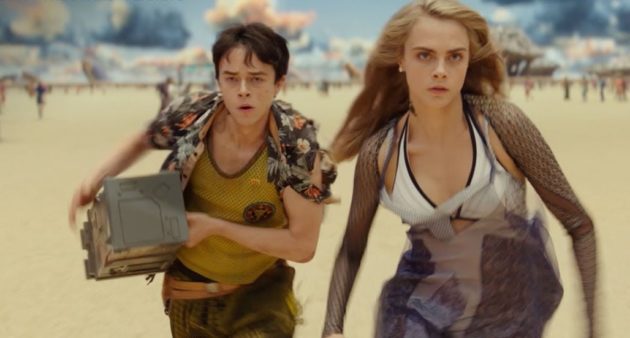
Spoiler alert: We’re not giving away any major plot points, but if you want to see “Valerian and the City of a Thousand Planets” before you read any reviews, stop reading now and come back later.
Does director Luc Besson’s latest movie, “Valerian and the City of a Thousand Planets,” live up to his sci-fi cult classic, “The Fifth Element”? Mmm, no. But the visuals and fictional tech concepts are literally out of this world, and well worth seeing.
“Valerian” has been getting decidedly mixed opening reviews – mostly due to the plodding plot and what some have called the anti-chemistry between the two lead actors, Dane DeHaan as Valerian and Cara Delevingne as Laureline. (To be fair, “The Fifth Element” got similarly mixed reviews when it premiered 20 years ago.)
The visuals are over-the-top, but the problem with “Valerian” may well be that it takes itself too seriously. The heroes and the villains are too earnest, in contrast to the cartoonish baddies in “The Fifth Element.” Ironically, a new movie based on a comic-book classic isn’t comic-bookish enough.
The best way to experience the movie is to set your expectations accordingly, and then let the computer-generated visual effects wash over you for two hours. Here are some of my favorite moments, based on the visuals as well as what they say about technologies to come.
How the Alpha space station grows: The movie starts out with a real-world encounter – the Apollo-Soyuz meetup between Soviet and American spacefliers in 1975. The historic handshake between Alexey Leonov and Tom Stafford is re-enacted aboard the Alpha space station, first with the Chinese in 2020, then with a rainbow of other nations, and then with a parade of exotic aliens. It’s a great opening sequence, set to the tune of David Bowie’s “Space Oddity.” Fun fact: Alpha was one of the proposed names for the International Space Station, but it never took. Reality check: the “Destiny module” you see later in the movie looks a lot like an Apollo spacecraft, and nothing like the Destiny module on the real-life space station.
Augmented-reality bazaars: Valerian and Laureline are dropped into a wide stretch of empty desert that’s transformed into a teeming bazaar when you put on glasses that look a lot like Microsoft’s HoloLens headsets. Visitors supposedly make their way through “the other dimension,” but it looks a lot like an augmented-reality environment where you can actually pick up virtual stuff and buy it. When you’re ready to bring your purchases out of the touristy bazaar, you put them through the augmented-realyt end of a “transmatter” device, and the real-world products come out the other side. That’s something to think about if you’re planning an augmented-reality shopping center for 3-D-printed goods. I wouldn’t be surprised if there’s already an Amazon patent application for that.
Haptic mind control: One of the cleverest tricks for Valerian’s raid on the market is to have one of his commandos jack into the nervous system of a guard who’s manning a machine gun in a watchtower. The commando gets a virtual view of the scene through the eyes of the zombified guard, and makes arm gestures that are mirrored up in the tower, with hilarious (or deadly) effect. Military researchers haven’t yet perfected that kind of haptic remote control, and let’s hope they never do. But researchers have been experimenting with haptic belts, vests and other gizmos that can provide soldiers with tactile cues about how to proceed in a combat situation.
Shape-shifting for fun and profit: In one scene, Valerian is wowed by a shape-shifter’s bravura performance, morphing from one sex-siren fantasy into another. The singer-songwriter Rihanna’s big-screen cameo as shape-shifting Bubble wowed the critics, too. The New York Post’s one-star review of the movie was headlined, “Rihanna Is the Only Good Part of ‘Valerian.'” Her shape-shifting strip tease, and her struggle as Bubble to take on a different and challenging role, serve as metaphors for the actor’s art. The closest thing to it in the natural world is a color-shifting cephalopod – which Bubble resembles in her true form.
Illegal immigrants in space: The closest that “Valerian” comes to real-world commentary is when Bubble laments her status as an alien on the Alpha station. “What good is freedom when you’re an illegal immigrant, far from home?” she asks. If there’s any message to be gotten from “Valerian,” perhaps it’s the message that we’ll survive to embrace the full rainbow of nations in the year 2150 – and extend a hand to any true aliens that come our way.



